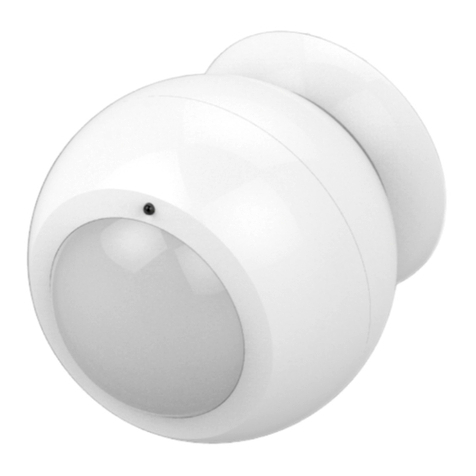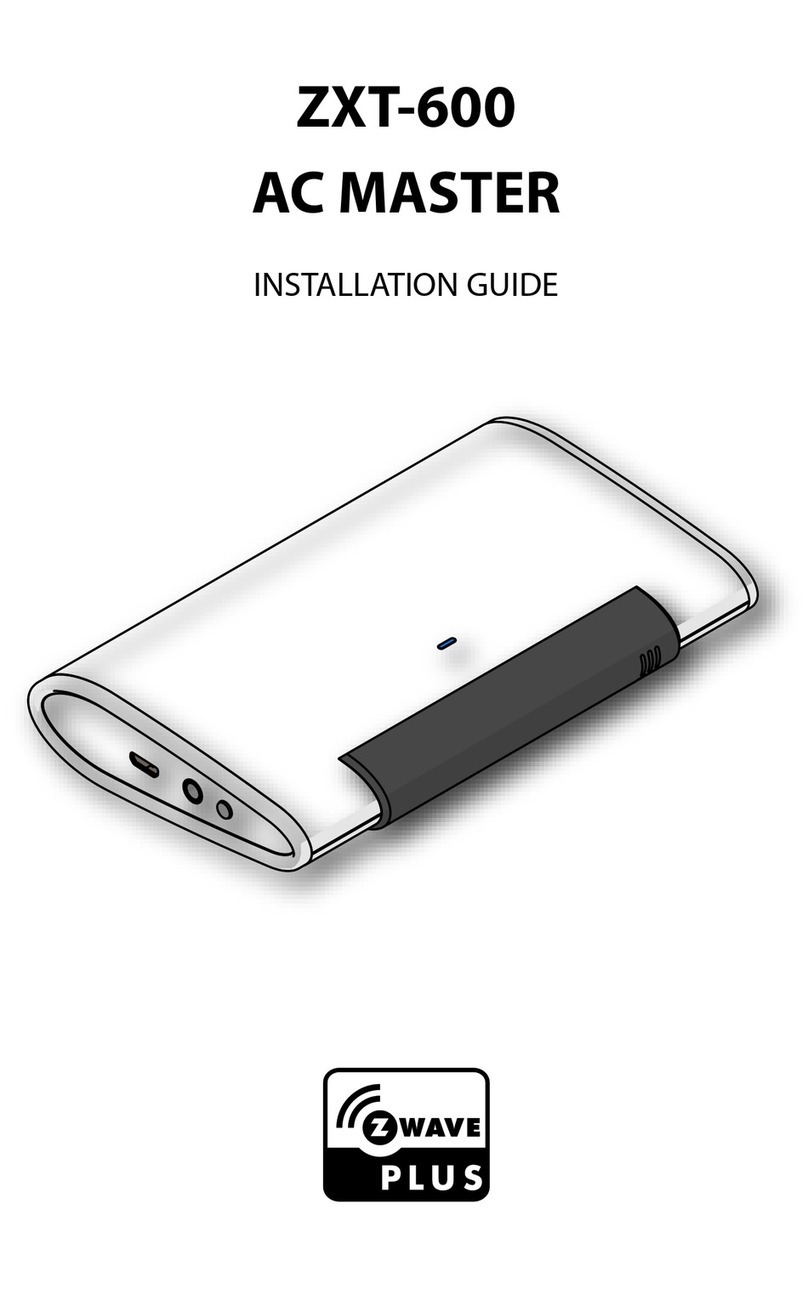
controls the value changes into Multilevel Switch Control (value=1). All other devices
will turn the button group into Basic Control (value=2). All configuration values can be
changed if needed.
When the Wall Controller is primary controller the very first device included will be
automatically put into button group A and the command set will change according to
the rules just mentioned. All other devices need to be put in button groups manually.
Factory Reset
The device can be set back to factory defaults without performing an
exclusion process. Please execute the following steps:
1. Turn the device into management mode
2. Click on button 3
3. Keep button 4 pushed for 10 seconds. For first 5 seconds the green LED
will blink, then it turns into long-red/short-green blinking until reset is
complete.
Please use this procedure only if the device is secondary controller and
the primary controller is missing or otherwise inoperable.
Behavior within the Z-Wave network
On factory default the device does not belong to any Z-Wave network. The device
needs to join an existing wireless network to communicate with the devices of this
network. This process is called Inclusion. Devices can also leave a network. This
process is called Exclusion. Both processes are initiated by the primary controller of
the Z-Wave network. This controller will be turned into exclusion respective inclusion
mode. Please refer to your primary controller’s manual on how to turn your controller
into inclusion or exclusion mode. Only if the primary controller is in inclusion or
exclusion mode, this device can join or leave the network. Leaving the network – i.e.
being excluded – sets the device back to factory default. If the device already
belongs to a network, follow the exclusion process before including it in your
network. Otherwise inclusion of this device will fail. If the controller being included
was a primary controller, it has to be reset first.
Please check the instructions in the quick start section how to include and exclude
the device from a network.
Operating the Device
Depending on the button mode and operating modes configured using the
configuration parameters the Wall Controller can be used in different ways.
Button Modes
4 Groups are controlled with single button (parameter 1/2 = 0)
The four buttons 1-4 control one single control group each: 1→A, 2→B, 3→C, 4→D.
Single click turns devices in the control group on, double click turns them off. Click
and hold can be used for dimming.
2 Groups are controlled with two buttons (parameter 1/2 = 1)
The buttons 1 and 3 control the control group A (button 1 turns on, button 3 turns
off), the buttons 2 and 4 control the control group B (button 2 turns on, button 4 turns
off). In case dimmers are controlled, holding down the larger button will dim up,
holding down the smaller button will dim down the load. Releasing the button will
stop the dimming function.
4 Groups are controlled with two buttons and double click (parameter 1/2 = 2)
This mode enhances the previous mode and allows to control two further control
groups C and D using double clicks. The devices supports 8 different operating
modes – this means the kind of commands sent out when pushing a button.
Operating modes either directly control other devices or they issue various scene
activation commands to a central controller.
The device supports 8 different operating modes – this means the kind of
commands sent out when pushing a button. Operating modes either directly control
other devices or they issue various scene activation commands to a central
controller.
The device supports 8 different operating modes – this means the kind of
commands sent out when pushing a button. Operating modes either directly control
other devices or they issue various scene activation commands to a central
controller.
Operating modes for direct device control are:
•Direct control of associated devices with On/Off/Dim commands
(parameter 11...14 = 1). Devices are controlled using Basic Set On/Off
commands and Switch-Multilevel Dim Start/Stop. This mode implements
communication pattern 7.
•Direct control of associated devices with only On/Off commands
(parameter 11...14 = 2). Devices are controlled using only Basic Set On/Off
commands. On dimming Up event On is sent, on dimming Down Off is sent.
This mode also implements communication pattern 7.
•Switch-All commands (parameter 11...14 = 3). In this mode all neighboring
devices will receive Switch-All set On/Off command and interpret it according to
their membership in Switch-All groups. This mode implements communication
pattern 7.
•Direct control of devices in proximity (parameter 11...14 = 6). Basic Set and
Switch-Multilevel Dim commands are sent to a device in proximity (50...100 cm)
from the controller. Attention: In case there are more than one Z-Wave devices
nearby all these devices may be switched. For this reason the proximity function
should be handled with care. This mode implements communication pattern 7.
•Door lock control (parameter 11...14 = 7). This mode allows direct control
(open/close) of electronic door locks using secure communication. The mode
implements communication pattern 7.
Operating modes for scene activation are:
•Direct activation of preconfigured scenes (parameter 11...14 = 5).
Associated devices in an association group are controlled by individual
commands defined by Z-Wave command class „Scene Controller
Configuration“. This mode enhances mode direct control of associated devices
with On/Off/Dim commands and implements communication patterns 6 and 7.
Please turn the button mode to „separate“ to allow different a scene ID on every
button.
•Scene activation in IP gateway (parameter 11...14 = 4). If configured
correctly the buttons can trigger a scene in a gateway. The scene number
triggered is a combination of the group number and the action performed on the
button and has always two digits. The group number defines the upper digit of
the scene number, the action the lower digit.
•The following actions are possible:
1 On | 2 = Off | 3 = Dim Up Start | 4 = Dim Down Start | 5 = Dim Up Stop | 6 =
Dim Down Stop
Example: Clicking/double clicking the button will issue scene triggers, scene 11
(button 1 click, event on), scene 12 (button double click 1, event off, single
button control is used in this example)
•Activation of central scenes (parameter 11...14 = 8, default). Z-Wave Plus
introduces a new process for scene activation – the central scene control.
Pushing a button and releasing a button send a certain command to the central
controller using the lifeline association group. This allows reacting both on
button push and button release. This mode implements communication patterns
6 but requires a central gateway supporting
Z-Wave Plus.
Child Protection
The device can be turned into a child protection mode. In this mode all local
operation is disabled.
The child protection mode MUST be turned on wirelessly. However in protected by
sequence mode it is possible to unlock the device for local operation by pressing
any button within 5 seconds. The unlock-state will last for 5 seconds.
Wake Up Intervals
This device is battery operated and turned into deep sleep state most of the time to
save battery life time. Communication with the device is limited. In order to
communicate with the device, a static controller C is needed in the network. This
controller will maintain a mailbox for the battery operated devices and store
commands that can’t be received during deep sleep state. Without such a controller,
communication may become impossible and/or the battery life time is significantly
decreased.
This device will wake up regularly and announce the wake up state by sending out a
so-called Wake Up Notification. The controller can then empty the mailbox.
Therefore, the device needs to be configured with the desired wake up interval and
the node ID of the controller. If the device was included by a static controller this
controller will usually perform all necessary configurations. The wake up interval is a
tradeoff between maximal battery life time and the desired responses of the device.
The device will stay awake right after inclusion for 10 seconds allowing the controller
to perform certain configuration. It is possible to manually wake up the device by
pushing button 2 in management mode. The minimum allowed wake up time is 240s
but it is strongly recommended to define a much longer interval since the only
purpose of a wake up should be the reporting of the battery status or an update of
the child protection settings. The device has a periodic wake up function however
this function is disabled by the configuration parameter #25. This will protect the
battery in case the controller is accidently configuring a wake up interval. A wake up
of the Wall Controller outside the range of the controller will lead to lots of
unsuccessful communication attempts draining the battery. Defining node ID of 0 as
a destination of the Wake Up Notification will disable the periodical wake up function
as well.
It is possible to set the node ID to 255 to send Wake Up Notifications as broadcast.
In this mode device takes more time to go to sleep and drains battery faster, but can
notify all its direct neighbors about a wake up.


























